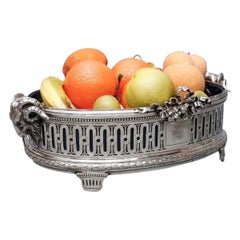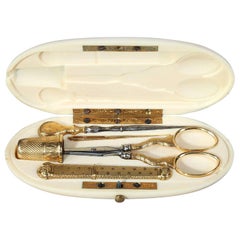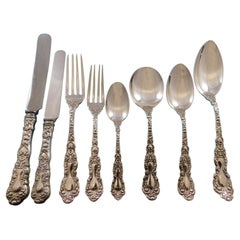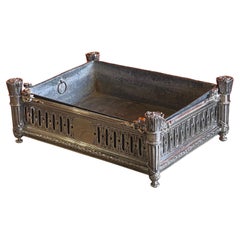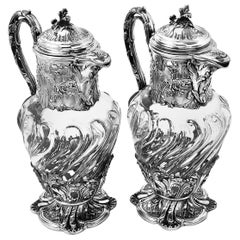A. Aucoc Furniture
4
to
4
4
4
4
2
4
1
1
4
3
3
2
1
4
4
2
460
316
250
193
Period: 19th Century
Creator: A. Aucoc
A.Aucoc – Solid Silver Sprinkler 19th Century Circa 1880
By A. Aucoc
Located in SAINT-OUEN-SUR-SEINE, FR
Important 19th century solid silver shaker in LOUIS The upper part is chiseled and pierced, it fits together with a bayonet system and ends with an exploded acorn on the terrace.
Di...
Category
Late 19th Century French Louis XIV Antique A. Aucoc Furniture
Materials
Sterling Silver
A.Aucoc - 19th Century Solid Silver Planter Napoleon III
By A. Aucoc
Located in SAINT-OUEN-SUR-SEINE, FR
Solid silver planter, oval LOUIS XVI style model, mounted on four straight legs, the body openwork with ribbed warheads, staples and oves, engraved with a coat of arms surmounted by ...
Category
Late 19th Century French Louis XVI Antique A. Aucoc Furniture
Materials
Sterling Silver
Aucoc - 166pc. Antique French 950 Sterling Silver & Vermeil Flatware Set + Chest
By A. Aucoc
Located in Wilmington, DE
Direct from Paris, A Magnificent 166pc. 950 Sterling Silver and Vermeil Flatware Set by Andre Aucoc "Silversmith to the Kings and Queens of Europe...
Category
1890s French Louis XVI Antique A. Aucoc Furniture
Materials
Vermeil, Sterling Silver
19th Century Sewing Box by Maison Aucoc, Paris
By A. Aucoc
Located in Paris, FR
Late 19th century oval sewing box decorated with crowned monogram. The case contains five gold and steel sewing utensils embellished with small flowers. Labeled on the inside: AUCOC A PARIS. Weight: 27.6 g,
circa 1860
Dimension: W 4.5 in, D 2.4in, H .8in.
Dimension: L 11.5cm, P 6cm, H 2cm.
La Maison Aucoc...
Category
19th Century French Napoleon III Antique A. Aucoc Furniture
Materials
Gold, Steel
Related Items
Imperial Chrysanthemum Gorham Sterling Silver Flatware Set Service 105 Pc Chest
By Gorham Manufacturing Company
Located in Big Bend, WI
Superb monumental dinner & luncheon size imperial Chrysanthemum by Gorham sterling silver flatware set, 105 pieces. This set includes:...
Category
20th Century A. Aucoc Furniture
Materials
Sterling Silver
Fantastic 19th Century French Dore Bronze Mounted Blue Opaline Crystal Box
By Baccarat
Located in New York, NY
A Fantastic 19th Century French Louis XVI Style Dore Bronze Mounted Blue Opaline Crystal Box. The box is composed of two sections of French opaline crystal which are mounted to a fa...
Category
1890s French Louis XVI Antique A. Aucoc Furniture
Materials
Crystal, Bronze
19th Century Chinoiserie Lacquer Sewing Box
Located in Toronto, CA
This is a remarkable 19th century lacquered sewing box with multiple compartments on the interior.
The exterior is decorated in elaborate black and gilded motifs including flowers, f...
Category
Early 19th Century Chinese Chinoiserie Antique A. Aucoc Furniture
Materials
Bone, Wood, Lacquer
19th Century Black Forest Carved Box
Located in London, GB
A Black Forest carved box
Constructed from stained and patinated Lindenwood, the lockable box carved to resemble a tied sheaf with its accom...
Category
19th Century Swiss Black Forest Antique A. Aucoc Furniture
Materials
Wood
Late 19th Century Desktop Tambour Letter Storage Box
Located in Casteren, Noord-Brabant
Beautiful antique box for letters / documents with a roller shutter door. The box is made of wood. In good condition, the tambour door opens smoothly. M...
Category
1880s French Belle Époque Antique A. Aucoc Furniture
Materials
Wood
Noailles by Puiforcat French 950 Sterling Silver Flatware Set Service 231 Pieces
By Jean Puiforcat
Located in Big Bend, WI
Noailles by Puiforcat French sterling silver dinner size flatware set, 231 pieces. This set includes:
36 dinner size knives, pistol grip, 10 1/4",
36 dinner size forks, 8",
18 sa...
Category
20th Century A. Aucoc Furniture
Materials
Sterling Silver
H 1 in W 1 in D 1 in
19th Century French Napoleon III Marquetry Sewing Box
Located in Winter Park, FL
A 19th Century French Napoleon III marquetry sewing box. Made of mahogany with thuya wood top inlaid with brass and mother of pearl. Brass trim frames the lid and the base. The inter...
Category
19th Century French Napoleon III Antique A. Aucoc Furniture
Materials
Brass
Antique George III Sterling Silver Salver by Paul Storr 1811 19th Century
By Paul Storr
Located in London, GB
This is a wonderful English antique George III sterling silver 10 inch salver, by the world famous silversmith Paul Storr.
It has clear hallmarks for London 1811 and the makers mark of Paul Storr.
It is typical of his work with the raised gadrooned rim with anthemion at intervals, on four fabulous foliate bracket feet. The salver is engraved with a crest and motto and the underside is later engraved
Charlotte J. Parke from C. J. Parke, March 1893'
The centre is engraved with a crest above a motto 'True and Fast' and I have researched this crest:
The Crest of Parke
The crest as engraved upon this George III English Sterling Silver Footed Salver by Paul Storr hallmarked London 1811 is that of the family of Parke. It may be blazoned as follows:
Crest: A stag’s head couped sable holding in the mouth a key or
Motto: True and fast
The family of Parke originally hailed from the County of Cumberland in the northeast of England1 later settling in the County of Dorset at Henbury House, Sturminster Marshal, near Wimborne. Given the evidence of the inscription found on the underside of the salver ‘Charlotte J. Parke from C. J. Parke, March 1893’ it was undoubtedly at one time in the possession of Charles Joseph Parke (died 9th March 1893) of Henbury House aforesaid and gifted to Charlotte Josephine Parke (baptised 4th January 1857 died 2nd January 1941) his third daughter by his wife, Ellen Mary Ethelston. I would venture the following hypothesis that the salver was bequeathed to Charlotte in her father’s will that was granted probate at London on the 20th May 1893. The ‘March 1893’ of the inscription acts as a remembrance of the month of the death of her father. It was noted that Charlotte’s father left an estate worth some £66,892, 19 shillings and one pence, a very considerable sum in the last decade of the 19th Century and even thereafter. Charlotte never married and was living at the time of her death at The Coppice, Sixpenny Handley in the County of Dorset. Her will was proved for probate at Llandudno on the 25th March 1941. She left an estate worth £18,866, 10 shillings and 4 pence. Again, a comfortable sum in 1941.
See the photo of Henbury House, Sturminster Marshal, near Wimborne, Co. Dorset. The former seat of the Parke family. The house was destroyed by fire, the remains of which were demolished in the 1990's.
There is no mistaking its unique quality and design, which is sure to make it a treasured piece by any discerning collector.
Condition:
In excellent condition with clear hallmarks and no dings, dents or signs of repair. Please see photos for confirmation.
Dimensions in cm:
Height 2 x Width 26.5 x Depth 26.5
Weight 0.69 kg
Dimensions in inches:
Height 1 inch x Width 10 inches x Depth 10 inches
Weight 1.5 lbs
Paul Storr
born in London England in 1771, was to become one of the most talented silversmiths of the nineteenth century. Today his legacy of exceptionally well crafted silver, found worldwide in museums and private collections, leaves one in awe when compared to that of his contemporaries.After having served a seven year apprenticeship from the age of 14, he began his career in 1792 when he went into a brief partnership with William Frisbee. This did not last and in 1793 a new mark, (his initials ‘P S’) was entered. By the beginning of the nineteenth century he had established himself as one of London’s top silversmiths producing, amongst others, commissions for Royalty.
In 1801 he married Elizabeth Susanna Beyer with whom he was to have ten children. In 1807 Paul Storr entered into a working relationship with Philip Rundell and by 1811 was a partner, and managing the workshops for Rundell, Bridge & Rundell.
During this period he kept his own marks and separate workshop. However it was through Rundell, Bridge & Rundell who were appointed Goldsmith in Ordinary to George III in 1804 that his reputation as a master silversmith grew. His talents lay in being able to transform ideas and designs from Rundell, Bridge & Rundell’s designers, William Theed...
Category
1810s English George III Antique A. Aucoc Furniture
Materials
Sterling Silver
Free Shipping
H 0.79 in W 10.44 in D 10.44 in
Tunbridge Ware Correspondence Box by Edmund Nye 19th Century
By Edmund Nye Tunbridge Wells
Located in Cheltenham, GB
Mid 19th century Tunbridge ware stationery box by Edmund Nye, manufacturer.
The dome-shaped top is inlaid with a specimen parquetry panel, crossbanded with boxwood and stringing and...
Category
19th Century English Georgian Antique A. Aucoc Furniture
Materials
Walnut, Satinwood, Ash, Boxwood
Solid Silver Tray, 19th Century
Located in Paris, FR
Solid silver tray, 19th century.
Hallmark Minerva.
Weight : 847g
Category
19th Century Antique A. Aucoc Furniture
Materials
Silver
19th Century Italian Sterling Silver Madonna, circa 1830
Located in Milano, IT
Embossed and engraved silver plaque
La Madonna del lago (The Madonna of the Lake)
Probably Milan, post 1824
Brass frame
It measures 16.14 in x 13.85 in (41 x 35.2 cm) and it weighs 10.357 pounds (4.698 g): silver 1.31 pounds (598 g) + brass 9.03 pounds (4.100 g)
State of conservation: some abrasions on the bottom. The frame is old, but not original.
The plaque is made up of a sheet of embossed and engraved silver, and held in a solid brass frame. It depicts the “Madonna del lago” – “Madonna of the Lake” - (the Madonna with Child and San Giovannino) by Marco d'Oggiono (Oggiono, 1474 circa - Milan, 1524 circa), while changing only the background landscape. Almost certainly the subject reproduced in the plaque was taken from a famous engraving by Giuseppe Longhi (Monza, 1766 - Milan, 1831), one of the greatest engravers of his era.
The silver is unmarked, probably because originally the Madonna was due to be exposed in a church: sometimes precious metals destined for worship and liturgical use would be exempted from payment and were, therefore, not marked.
It is very likely that the plaque was made in Milan because in this city in 1824 the engraving by Giuseppe Longhi was made and printed. In addition, in Milan, the alleged lost painting by Leonardo da Vinci in his Milanese period (1482-1500) would be produced; this is the painting from which Marco d'Oggiono took his version.
The painting
Marco d?Oggiono was one of Leonardo da Vinci's most brilliant students and collaborators (D. Sedini, Marco d’Oggiono, tradizione e rinnovamento in Lombardia tra Quattrocento e Cinquecento, Roma 1989, pp. 151-153, n. 56; p. 225, n. 124, with previous bibliography). His style reflects in every way that of the Tuscan Maestro, so much so that he was the one who executed some copies of da Vinci's paintings. The execution of the “Madonna del Lago” probably draws inspiration from a lost painting by the Maestro, created while he was living in Milan (1482-1500). There are many similarities with other works by Leonardo such as the “Vergine delle rocce” or the “Vergine con il Bambino e San Giovannino, Sant’Anna e l’Agnello”.
The painting, from which the drawing and then the famous engraving were taken, is found today at the M&G Museum of Bob Jones University in Greenville, South Carolina, where it came to rest after the sale of the Harrington Collection in London in 1917.
The work appears in the inventories of the collection of Napoleon and Joséphine Bonaparte at the castle of Malmaison, before 1809.
The Malmaison building was born and developed in the 17th and 18th centuries. In the 18th century it belonged to Jacques-Jean Le Coulteux du Molay, a wealthy banker. Later, during the Directory, Joséphine Bonaparte de Beauharnais bought it on April 21st, 1799, but settled at the castle definitively only after her husband separated from her in 1809. She remained there until 1814, the year of her death. When Joséphine died, the estate passed to her son Eugène de Beauharnais, who moved to Munich with his whole family in 1815, bringing with him the collection of paintings he inherited from his mother. Eugène died in 1824 and his wife Augusta of Bavaria (von Bayern), unable to keep it, in 1828 sold the Malmaison to the Swedish banker Jonas-Philip Hagerman.
It is likely that in this period Augusta also sold part of the paintings inherited from her husband, including the “Madonna del Lago”. This painting then came into the possession of Leicester Stanhope, fifth Earl of Harrington (1784 - 1862) and then was passed down to his descendants.
In 1917, at the death of Charles, eighth Earl of Harrington, his brother Dudley inherited the title and properties and he put up a part of his collections for sale. Among these, precisely, the painting by Marco d'Oggiono was to be found.
On the occasion of that auction the painting was presented as a work by Cesare da Sesto, by virtue of a handwritten note by the Countess of Harrington on the back of the table. However, already in 1857, the German critic Gustav Waagen had identified Marco d'Oggiono as the author of the painting, then exhibited in the dining room of Harrington House in London (Treasures of Art in Great Britain, in 4 volumes, London, 1854 and 1857).
The engraving
Giuseppe Longhi was one of the most renowned engravers in Italy between the end of the 18th century and the first quarter of the 19th century.
In 1824 Giuseppe Longhi, based on a design by Paolo Caronni, made a famous engraving of the painting of Marco d?Oggiono. The activity of Longhi was then at the peak of his notoriety, enough to earn him very substantial commissions; it is not risky to suppose that some of his successful engravings were also reproduced using other means: in our case in silver. (A. Crespi, a cura di, Giuseppe Longhi 1766–1831 e Raffaello Morghen...
Category
1820s Italian Neoclassical Antique A. Aucoc Furniture
Materials
Sterling Silver, Brass
19th Century Chinese Lacquer Sewing Box
Located in Brea, CA
19th century Chinese lacquer sewing box from the Qing Dynasty. Decorated all over beautifully with intricate designs and images of ancient C...
Category
19th Century Chinese Qing Antique A. Aucoc Furniture
Materials
Lacquer
Previously Available Items
Antique Solid Silver Jardinere / Planter Box with Insert by Andre Aucoc
By A. Aucoc
Located in San Diego, CA
Large antique solid silver Napoleon III era jardinere / table top planter by Andre Aucoc, circa late 1800s. This gorgeous piece with a pierced galler...
Category
Late 19th Century French Napoleon III Antique A. Aucoc Furniture
Materials
Sterling Silver, Lead
H 5.25 in W 14.5 in D 10.75 in
Pair Antique French Silver & Glass Claret Jugs Wine Decanter Paris France c 1880
By A. Aucoc
Located in London, GB
A beautiful pair of Antique French solid Silver and cut Glass Claret Jugs in a elegant Rococo design. The Jug has ornate shell, scroll and foliate design on the neck complimented by ...
Category
19th Century French Rococo Antique A. Aucoc Furniture
Materials
Silver
Free Shipping
H 0.4 in W 0.4 in D 0.4 in
Antique French Solid Silver Pair of Seven-Light Candelabra, A. Aucoc, circa 1890
By A. Aucoc
Located in Royal Tunbridge Wells, Kent
Antique early-20th Century pair of magnificent and exceptional French seven-light candelabra, very large and exceptionally heavy (9590 grams of high-grade solid silver), cast in the ...
Category
1890s French Antique A. Aucoc Furniture
Materials
Silver
Free Shipping
H 22.33 in Dm 12.8 in
A. Aucoc furniture for sale on 1stDibs.
A. Aucoc furniture are available for sale on 1stDibs. These distinctive items are frequently made of metal and are designed with extraordinary care. There are many options to choose from in our collection of A. Aucoc furniture, although silver editions of this piece are particularly popular. Many of the original furniture by A. Aucoc were created in the Louis XVI style in france during the 19th century. If you’re looking for additional options, many customers also consider furniture by Eugene-Antoine Aizelin, Maison Giroux, and Jean-Baptiste Carpeaux. Prices for A. Aucoc furniture can differ depending upon size, time period and other attributes — on 1stDibs, these items begin at $2,695 and can go as high as $43,356, while a piece like these, on average, fetch $5,150.

